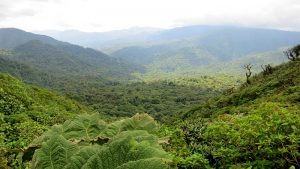The Wildlife Conservation Society (WCS) has published the first images in years of a group of Cross River gorillas – a subspecies on the verge of extinction – with a number of infants and young specimens of different ages!
The images were taken in the Mbe mountains in Nigeria. Cross River gorillas (Gorilla gorilla diehli) are the most endangered gorilla subspecies, with only 300 individuals located in an isolated region along the border between Nigeria and Cameroon.
Seeing a Cross River gorilla in the wild is already exceptional in itself, let alone photographing them, even with remote cameras. Previously, camera traps placed on WCS-managed sites in Cameroon and Nigeria had captured only a few images, including one from 2012 in the Kagwene Gorilla Sanctuary in Cameroon, where a member of the group was seen with an amputated hand, probably the result of a poacher’s trap.
In 2013, a mother carrying a newborn on her back and another young specimen had been photographed at different times in the Mbe and Afi mountains in Nigeria. This is the first time that multiple Cross River gorilla babies have been photographed in the same herd.
The Cross River gorillas live in the most inaccessible areas of their natural habitat, as they are extremely wary because of a long history of being hunted by men. Their presence can be detected mainly by indirect signs such as nests, dung and traces of food. They are distributed in a fragmented way over a mountainous and wooded landscape that extends for about 12 thousand square kilometers across the cross-border region between Cross River in Nigeria and Takmanda-Mone in Cameroon.
Long believed to be extinct, they were “rediscovered” in Nigeria in the late 1980s. Currently about 100 Cross River gorillas live in Nigeria at three contiguous sites in Cross River State – the Okwangwo division of the Cross River National Park (Okwangwo), the AFI Mountain Wildlife Sanctuary and the forest of the MBE mountain community. The MBE forest, which is home to about a third of the Nigerian gorilla population (and provides an important link between the Afi mountain and Okwangwo) is jointly managed by the Wildlife Conservation Society (WCS) and the Conservation Association of the MBE Mountains as a sanctuary.
This success is largely due to support and commitment of local community partners.
"I am very happy," said Otu Gabriel Ocha, head chief of nearby village. "Shows that our conservation efforts in partnership with @WCS_Nigeria are yielding fruits."
More: https://t.co/Hms6bV7pBn pic.twitter.com/mVhGZj7NMz
— WCS (@TheWCS) July 8, 2020
The company said it collaborated with several communities to ensure the protection of gorillas, and since 2012 there have been no recorded or reported deaths in Nigeria. Gabriel Ocha, head of Kanyang (one of the villages near the MBE mountains) said that the images are proof that his community’s conservation efforts with the WCS are paying off.
—
Source: Good News Network







